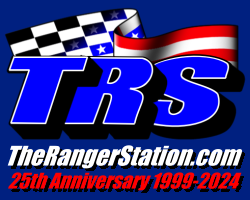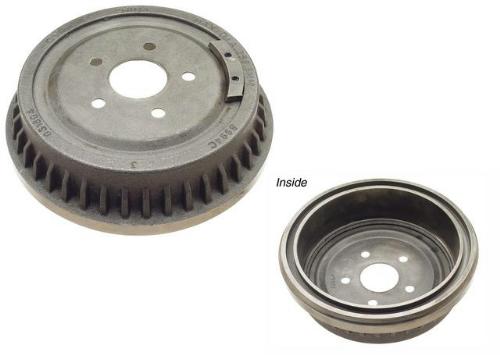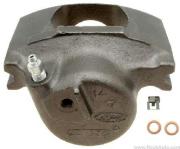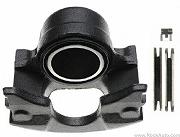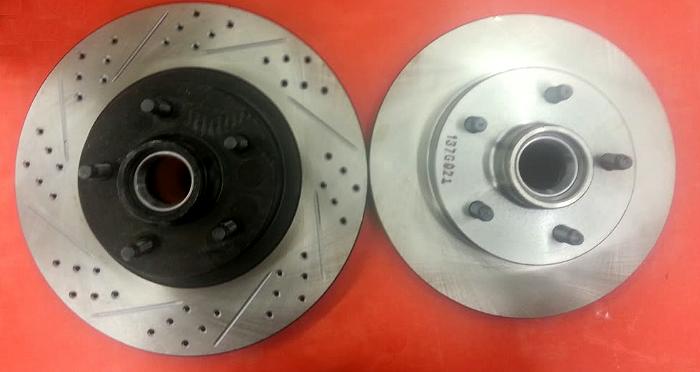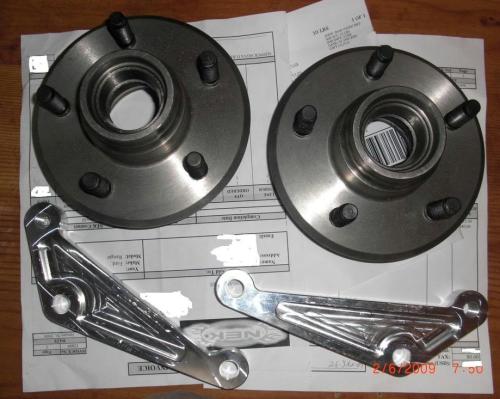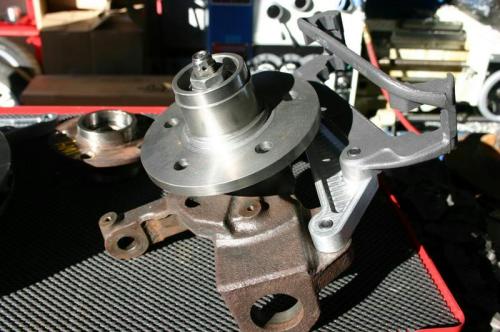Ford Rangers come with a rear drum and front disk brake set-up from 1983-2009. In 2010 and 2011, the Ford Ranger received rear disc brakes.
In 1995, the Ford Explorer switched from a rear drum to a rear disc brake setup.
If you’re building up a Ranger and you feel that the rear brakes are insufficient, you should probably switch to a 1995 or newer Explorer 8.8-inch rear axle with disc brakes. Yes, there are methods for swapping your rear drums for rear discs, but why not just swap in an axle already designed to use them?
Ford Ranger Overview:
Rear:
The Ranger uses a 9-inch rear drum. Limited slip rear axles and vehicles with a GVWR over 4580 pounds use a 10-inch drum.
If your early Ranger Bronco II has 9-inch drums, upgrading to 10-inch drums is a surprisingly effective alternative. Search the junkyard for either a later Ranger, or even easier an Aerostar to serve as a donor.
10-Inch Aerostar Brake Drums:
If you already have 10-inch drums (most 1988-up Supercabs, 4×4’s and 1991-1994 Explorers), you can improve fade resistance by replacing your “smooth” 10-inch drums with the heavier “finned” drums that are specified for the 1993-1997 Aerostar.
(Ford Aerostar 10-Inch Finned Brake Drum)
Retrofit 10-Inch Drums:
If you want to upgrade from the 9-inch rear drums to 10-inch rear drums, you’ll need the:
-
backing plate
-
Wheel cylinders
-
Emergency brake cable
-
10-inch drums
The wider 10-inch drums will not widen your rear track width. The backing plates for the 10-inch drums are offset so that it has the same width as the 9-inch.
Also, the Ford Ranger 7.5-inch axle and Ford Ranger 28-spline 8.8-inch axle have the same axle flange bolt pattern. So a backing plate from a Ford Ranger 8.8 will fit a Ford Ranger 7.5.
Factory Rear Discs:
For 2010 and 2011, the Ford Ranger came with rear disc brakes.
(Factory rear disc brakes on 2010 Ford Ranger)
Front:
The Ranger uses a 10.28 inch diameter, 0.850 inch thick front brake rotor.
The 4×4 models use a 10.86 inch diameter rotor.
The 1983-1994 front brake is a single piston caliper with slide pins.
(Single Piston Caliper)
In 1995 the caliper was upgraded to a dual piston (2-piston) caliper and the rotor was upgraded to 1.023 inches thick. The caliper bolts to the steering knuckle and does not use slide pins.
(Dual Piston Caliper)
Dual Piston Upgrade:
1989-1994: In order to add the dual piston (2-piston) caliper and larger rotor to your 1989-1994 Ford Ranger (or 1989-1990 Ford Bronco II), you’ll need to swap your existing steering knuckle to a 1995-1997 knuckle.
If you want the new brakes to be easy to connect on a 1989-1994 (and some late 1988’s) you need to order a NON-ABS Brake hose for the drivers side from a 1997. 1997 was the ONLY year that ford made any Non-ABS two piston trucks (I have no idea why).
The 1989-1994’s without ABS use the frame end of the drivers side brake hose as a T-block to split the brake line off the master cylinder to the left and right side brakes (Thus the NON ABS hose) If on the other hand you have an ABS equipped 1993-1994 you want the ABS hoses.
1983-1988: These axle beams are different than the 1989-1997 beams. In 1989, Ford moved the ball joints from the beam to the steering knuckle. So you can not swap the 1995-1997 steering knuckles on to these beams. The dual piston calipers will only fit the 1995-1997 steering knuckles, and those knuckles can only be swapped on to the 1989-1994 beams. So if you have a 1983-1988, you’ll need to swap in a 1989-1994 beam, or swap in a 1995-1997 beam with the dual piston calipers.
The 1983-1988 Ford Ranger / Bronco II (except for some late 1988’s) have a separate T-block mounted to the frame that divides the brake line, and a short line that runs from the block to the drivers side hose. So, the 1995-1997 ABS hose will work fine
Dana 35: On a Dana 35 or Dana 35 hybrid truck (Dana 35 beam with Dana 28 gears) you swap over the 1995-1997 Ranger steering knuckles, calipers, caliper brackets and rotors (the spindle, shaft, lockout hubs, etc are all the same and interchangeable).
If you are retrofitting a two-piston brake Dana 35 TTB (1995-1997 Dana 35) on to an earlier Ranger or Bronco II, you specifically want the ABS style brake hoses.
12-Inch & 13-Inch Brake Rotors:
12-Inch Rotors: In 2003, the ford Explorer Sport Trac upgraded to a 12-Inch brake rotor. Some Ranger owners have found a way to convert their trucks to use this larger rotor. You will however need a 16-inch wheel to clear them.
(12-inch rotor left – Stock 10-inch rotor right)
Click HERE to learn more.
13-Inch Rotors: There was a member (Tee Rev) at RPS that machined a hub and made a bracket to allow a 13-inch Mustang brake rotor to fit on the 1995-1997, and the 1999-2003 Ford Ranger. It would also work on the 1989-1994 Rangers if they were refitted with 1995-1997 steering knuckles. The kit is no longer sold.
Master Cylinder:
4×2 models use a 0.938 inch master cylinder bore.
4×4 models use a 0.975 master cylinder bore.
Ford Explorer Overview:
Rear:
The Explorer uses a 9-inch rear drum. Limited slip rear axles and vehicles with a GVWR over 4580 pounds use a 10-inch drum.
In 1995 the drum brakes were replaced with a 0.472 inch brake rotor.
If you have a 1991-1994 Explorer with drums, the 1995-2001 Discs DO bolt directly onto the 1991-1994 Explorer drum brake axle. You’ll need to grab everything from the backing plates forward. The 1995-2001 Discs DO NOT bolt to the Ford Ranger 8.8-inch axle.
Front:
The Explorer uses a 10.28 inch diameter, 0.850 inch thick front brake rotor. The 4×4 models use a 10.86 inch diameter rotor. In 1995 the rotor was upgraded to 1.023 inches thick.
Master Cylinder:
4×2 models use a 0.938 inch master cylinder bore.
4×4 models use a 0.975 master cylinder bore.
1995 and newer models are shown with only having a 0.938 cylinder bore.
Rear Disc Brake Conversions:
1990-1994 Ford Explorer 31-Spline 8.8-Inch Axle:
If you swapped in a 1990-1994 Ford Explorer 8.8-inch axle with drum brakes, you can swap all of the rear disc brake components from a later 1995-2001 ford Explorer.
Ford Ranger 28-Spline 8.8-Inch & 7.5-Inch Axles:
The most common way to add disc brakes to these axles has been to do the “Mustang Disc Brake Swap“. It’s not a direct bolt on because it requires some cutting, but it isn’t to difficult for the average guy that works on his truck.
More on Front Brakes from AllanD:
Here is a short explanation of factory front brakes on Rangers, Bronco II’s and Explorers;
1983-1994:
Starting in 1983 and continuing to the end of 1994, Ford used a “split pin” mounted caliper. With the exception of some 1986 and early 1987 (through the end of February 1987) Ford used the same caliper on ALL Ranger based vehicles AND the Aerostar.
1995-1997:
The 1995-current front brakes use a 2-piston caliper and caliper bracket. The bracket locates the pads and the caliper simply squeezes them. Additionally, the bracket being removable make the steering knuckle a “non-wear” item.
Look closely at the “integral” caliper bracket on any split-pin caliper equipped Ranger and you might see what I am referring to. The pad thrust surfaces tend to get rather hammered.
Comments & Responses:
Comment – This is no good to me. I already have aftermarket longer stainless hoses and they are marketed for a ’83-’97 Ranger.
AllanD Response – that’s because most aftermarket hoses lack a rigid tube section. And what is different between the various calipers is the rigid section of the line to specifically accommodate those different calipers.
Comment – The ’93 and ’97 non ABS uses the same rotors; I installed new ’93 rotors on my ’97 when I had it. The ’97 I had didn’t have ABS on the front.
AllanD Response – The “late” rotors will certainly fit onto the early truck.
It’s even possible the aftermarket suppliers “cheaped out” and stopped making the early style D35 rotors, but when I first looked into doing this swap I examined everything VERY carefully specifically looking for differences…
What I found was that relative to the wheel bearings the friction disc as moved outwards 8-10mm.
The difference is enough to allow a 1990-94 to “spit” the inboard pad after only slight wear if someone ignorant of the difference accidentally installs a 95-97 rotor onto a 1990-94 vehicle.
The reason for this was revealed when I tried to install a 1993 rotor (from my explorer engine donor) onto the 1996 Ranger beam I was using and discovered that the back friction surface of the rotor was in hard contact with the heads of the caliper bracket bolts.
Most parts listings I’ve seen show different rotors (both ABS and Non-ABS) for the 1995-97 Vs the 1990-1994. For what it’s worth, BOTH my 1993 Explorer “organ donor” and the 1996 Dana 35 Ranger axle were ABS equipped.
So I’ll say “ya need different rotors” until proven otherwise beyond all doubt I won’t be holding my breath waiting to be proven wrong.
Generally speaking if I find a parts listing that disagrees with what I know I usually dispute that parts listing. I’ve seen it enough times to know that the paper just lies there and lets some idiot print any combination of symbols and pictures on it without complaint.
For example, how many here have been asked “what axle ratio” when buying brake parts for a 1991-1997 Ranger? answered 3.45 THEN been given the WRONG parts.
Ditto for telling the parts counterman that you have an 8.8″ axle when buying outer axle bearings…
Or asking for a pilot bearing for a 1988-up 4cyl (or for any year 3.0 engine or 4.0 engine) and being asked Mazda or Mitsubishi trans?
Yes the pilot bearing is different, but that’s not the point, the point is that 1988-up the Mitsubishi trans was 2.9 engine ONLY. 2.3, 3.0 & 4.0 were Mazda only.
